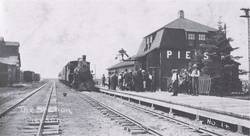The Rise of a Town Planted Beside the Railway
1891 - Present
The Canadian Pacific Railway (CPR) laid tracks through what would be the village of Pierson in 1891. The CPR soon sent out a surveyor who subdivided lots for a town. Merchants Alfred Gould and David Elliot from Sourisford made the first purchase on these lots. They established Pierson’s first business, a grocery store. The CPR used the money it made from selling lots in town to build more railway and maintain the line.
February of 1892 saw the first train rumble down the tracks. In short order three grain elevators were built beside the tracks by different companies to take delivery of local farmers’ crops. In 1900 this number had risen to four.

The train station at Pierson was a busy place. Lyleton was not serviced by rail until 10 years later, so farmers from that region relied on Pierson’s station as a place to drop off their grain. Pierson was also well situated on the rail line to receive coal from the coal mines near Estevan. During years when coal was scarce, such as 1901 and 1906, a group of wagons or sleighs formed an anxious line-up in front of the coal car, hoping that when they reached the front of the line there would still be coal left to fuel their fires at home.
Though the train is still an important means of transporting goods to and from Pierson, its use as a passenger service was temporary. The train station as a gathering place and area of social activity came to an end in May 1959 when the last passenger train arrived in Pierson.
James Dandy was an active entrepreneur in Pierson. He owned the first hardware, furniture and lumber businesses. In 1900 Dandy financed the building of the Leland Hotel, which catered to travelling businessmen, doctors, dentists and incoming settlers.
The village of Pierson was soon decked out with all of the shops and businesses necessary to make the community flourish: a blacksmith shop, millinery shop, wheelwright, livery barn, butcher shop, lumberyard, drug store, jewellery store, bank, barbershop, and café, among others. A bakery was operated by Ben Shannon from 1903 to 1908. Instead of receiving change for their purchases, sometimes customers received a token that could be spent on one loaf of bread. It was a luxury at that time to be able to run down to the bakeshop and buy a banana from an entire cluster that hung from a hook in the ceiling at the back.
Today the economy of Pierson is still based in agriculture. The village’s 200 residents have recently seen oil exploration provide an extra boost to the economy of the region.
A Foreign Connection
The town of Pierson, Manitoba is linked through its name to Holland.
Pierson is the name of one of the partners of a Dutch banking firm who provided financing to the CPR. The prairie towns of Boissevain, MB and Bienfait, SK also took their names from partners in this company. In 1875 the firm was established as Adolph Boissevain & Co. This changed to Pierson & Co. when Jean Louis Pierson rose to become the company’s head. This firm still exists today under the name Pierson, Hendring and Pierson.
When the Pierson CPR station was closed in 1971, the wall clock from the building (along with other instruments and office furnishings) were sent to Amsterdam where they are housed at the banking firm’s head office.
. . . . .
Related Articles:
. . . . .
Author: Teyana Neufeld, 2010.
Source:
RM of Edward History Book Committee. Harvests of Time. Altona: Friesen Printers, 1983.
Photo: Above source.
